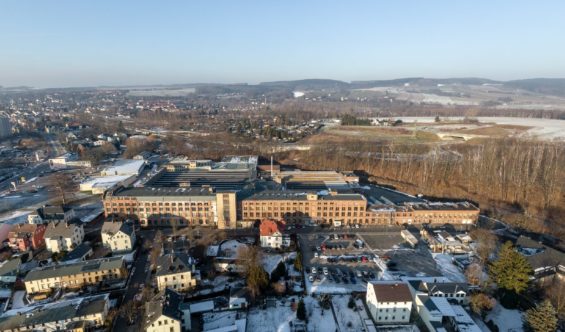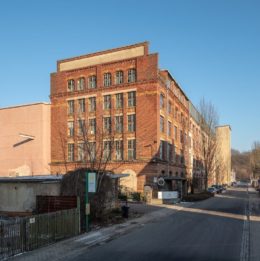Flöha Subcamp
March 1944 – April 14, 1945
![]()
Aerial photo of the former factory grounds in Flöha, 2019 (Flossenbürg Concentration Camp Memorial / Photo: Rainer Viertlböck)
![]()
The former tulle factory in Flöha, 2019 (Flossenbürg Concentration Camp Memorial / Photo: Rainer Viertlböck)
-
Prisoners
Over 330 Russian, 180 French, over 80 Polish (24 of them Jewish) prisoners. The prisoner numbers fluctuated due to numerous transfers, highest figure: 611 men (February 1945). Many prisoners had performed forced labor beforehand at the Erla-Werke in the Leipzig area while imprisoned in the subcamps of the Buchenwald concentration camp.
-
Forced labor and quarters
Production of fuselage parts for the Me 109 fighter jet (manufacturing in license for the Leipzig Erla Maschinenwerk GmbH). The production and accommodation quarters of the prisoners were in the disused Fortuna tulle factory. The multi-story building was enclosed by a fence and surrounded by guard towers.
-
Guards
Between 54 and 68 SS guards. Detail leader Brendel severely mistreated the prisoners and murdered at least five of them.
-
Death toll
42 deaths are documented, although many ill prisoners were transferred to Flossenbürg. After escape attempts by at least ten prisoners, some were murdered in Flossenbürg.
-
Disbanding of the camp / end of the war
The camp was disbanded on April 14, the prisoners forced to march towards the Czech border and then through northern Bohemia to Theresienstadt. Detail leader Brendel ordered the shooting of at least 60 prisoners.
-
Commemoration
At the beginning of the 1950s a large monument was erected at the textile factory; today the factory is vacant. Polish victims of the subcamp are buried in the cemetery of the Church of Resurrection.

